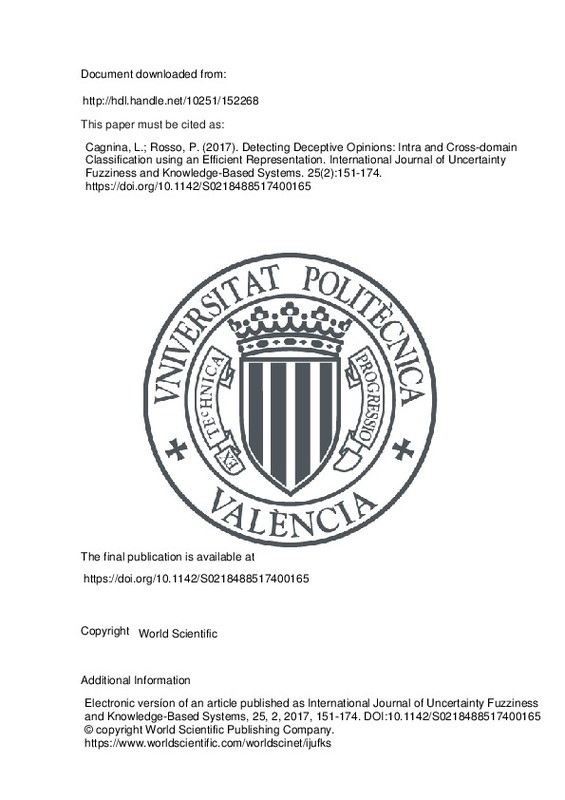JavaScript is disabled for your browser. Some features of this site may not work without it.
Buscar en RiuNet
Listar
Mi cuenta
Estadísticas
Ayuda RiuNet
Admin. UPV
Detecting Deceptive Opinions: Intra and Cross-domain Classification using an Efficient Representation
Mostrar el registro sencillo del ítem
Ficheros en el ítem
| dc.contributor.author | Cagnina, Leticia
|
es_ES |
| dc.contributor.author | Rosso, Paolo
|
es_ES |
| dc.date.accessioned | 2020-10-17T03:32:22Z | |
| dc.date.available | 2020-10-17T03:32:22Z | |
| dc.date.issued | 2017-12 | es_ES |
| dc.identifier.issn | 0218-4885 | es_ES |
| dc.identifier.uri | http://hdl.handle.net/10251/152268 | |
| dc.description | Electronic versíon of an article published as International Journal of Uncertainty Fuzziness and Knowledge-Based Systems, 25, 2, 2017, 151-174. DOI:10.1142/S0218488517400165 © copyright World Scientific Publishing Company. https://www.worldscientific.com/worldscinet/ijufks | es_ES |
| dc.description.abstract | [EN] Online opinions play an important role for customers and companies because of the increasing use they do to make purchase and business decisions. A consequence of that is the growing tendency to post fake reviews in order to change purchase decisions and opinions about products and services. Therefore, it is really important to filter out deceptive comments from the retrieved opinions. In this paper we propose the character n-grams in tokens, an efficient and effective variant of the traditional character n-grams model, which we use to obtain a low dimensionality representation of opinions. A Support Vector Machines classifier was used to evaluate our proposal on available corpora with reviews of hotels, doctors and restaurants. In order to study the performance of our model, we make experiments with intra and cross-domain cases. The aim of the latter experiment is to evaluate our approach in a realistic cross-domain scenario where deceptive opinions are available in a domain but not in another one. After comparing our method with state-of-the-art ones we may conclude that using character n-grams in tokens allows to obtain competitive results with a low dimensionality representation. | es_ES |
| dc.description.sponsorship | This publication was made possible by NPRP grant #9-175-1-033 from the Qatar National Research Fund (a member of Qatar Foundation). The statements made herein are solely the responsibility of the authors. | es_ES |
| dc.language | Inglés | es_ES |
| dc.publisher | World Scientific | es_ES |
| dc.relation.ispartof | International Journal of Uncertainty Fuzziness and Knowledge-Based Systems | es_ES |
| dc.rights | Reserva de todos los derechos | es_ES |
| dc.subject | Cross-domain evaluation | es_ES |
| dc.subject | Deception detection | es_ES |
| dc.subject | Intra-domain evaluation | es_ES |
| dc.subject | Low dimensionality representation | es_ES |
| dc.subject | Opinion spam | es_ES |
| dc.subject.classification | LENGUAJES Y SISTEMAS INFORMATICOS | es_ES |
| dc.title | Detecting Deceptive Opinions: Intra and Cross-domain Classification using an Efficient Representation | es_ES |
| dc.type | Artículo | es_ES |
| dc.identifier.doi | 10.1142/S0218488517400165 | es_ES |
| dc.relation.projectID | info:eu-repo/grantAgreement/QNRF//NPRP 9-175-1-033/ | es_ES |
| dc.rights.accessRights | Abierto | es_ES |
| dc.contributor.affiliation | Universitat Politècnica de València. Departamento de Sistemas Informáticos y Computación - Departament de Sistemes Informàtics i Computació | es_ES |
| dc.description.bibliographicCitation | Cagnina, L.; Rosso, P. (2017). Detecting Deceptive Opinions: Intra and Cross-domain Classification using an Efficient Representation. International Journal of Uncertainty Fuzziness and Knowledge-Based Systems. 25(2):151-174. https://doi.org/10.1142/S0218488517400165 | es_ES |
| dc.description.accrualMethod | S | es_ES |
| dc.relation.publisherversion | https://doi.org/10.1142/S0218488517400165 | es_ES |
| dc.description.upvformatpinicio | 151 | es_ES |
| dc.description.upvformatpfin | 174 | es_ES |
| dc.type.version | info:eu-repo/semantics/publishedVersion | es_ES |
| dc.description.volume | 25 | es_ES |
| dc.description.issue | 2 | es_ES |
| dc.relation.pasarela | S\358203 | es_ES |
| dc.contributor.funder | Qatar National Research Fund | es_ES |
| dc.description.references | Cambria, E. (2016). Affective Computing and Sentiment Analysis. IEEE Intelligent Systems, 31(2), 102-107. doi:10.1109/mis.2016.31 | es_ES |
| dc.description.references | Cambria, E., & Hussain, A. (2015). Sentic Computing. Cognitive Computation, 7(2), 183-185. doi:10.1007/s12559-015-9325-0 | es_ES |
| dc.description.references | Hall, M., Frank, E., Holmes, G., Pfahringer, B., Reutemann, P., & Witten, I. H. (2009). The WEKA data mining software. ACM SIGKDD Explorations Newsletter, 11(1), 10-18. doi:10.1145/1656274.1656278 | es_ES |
| dc.description.references | Hancock, J. T., Curry, L. E., Goorha, S., & Woodworth, M. (2007). On Lying and Being Lied To: A Linguistic Analysis of Deception in Computer-Mediated Communication. Discourse Processes, 45(1), 1-23. doi:10.1080/01638530701739181 | es_ES |
| dc.description.references | Hernández Fusilier, D., Montes-y-Gómez, M., Rosso, P., & Guzmán Cabrera, R. (2015). Detecting positive and negative deceptive opinions using PU-learning. Information Processing & Management, 51(4), 433-443. doi:10.1016/j.ipm.2014.11.001 | es_ES |
| dc.description.references | Mann, H. B., & Whitney, D. R. (1947). On a Test of Whether one of Two Random Variables is Stochastically Larger than the Other. The Annals of Mathematical Statistics, 18(1), 50-60. doi:10.1214/aoms/1177730491 | es_ES |
| dc.description.references | MONTAÑÉS, E., QUEVEDO, J. R., COMBARRO, E. F., DÍAZ, I., & RANILLA, J. (2007). A HYBRID FEATURE SELECTION METHOD FOR TEXT CATEGORIZATION. International Journal of Uncertainty, Fuzziness and Knowledge-Based Systems, 15(02), 133-151. doi:10.1142/s0218488507004492 | es_ES |
| dc.description.references | Newman, M. L., Pennebaker, J. W., Berry, D. S., & Richards, J. M. (2003). Lying Words: Predicting Deception from Linguistic Styles. Personality and Social Psychology Bulletin, 29(5), 665-675. doi:10.1177/0146167203029005010 | es_ES |
| dc.description.references | Raudys, S. J., & Jain, A. K. (1991). Small sample size effects in statistical pattern recognition: recommendations for practitioners. IEEE Transactions on Pattern Analysis and Machine Intelligence, 13(3), 252-264. doi:10.1109/34.75512 | es_ES |
| dc.description.references | Wang, G., Xie, S., Liu, B., & Yu, P. S. (2012). Identify Online Store Review Spammers via Social Review Graph. ACM Transactions on Intelligent Systems and Technology, 3(4), 1-21. doi:10.1145/2337542.2337546 | es_ES |
| dc.description.references | Webb, G. I. (2000). Machine Learning, 40(2), 159-196. doi:10.1023/a:1007659514849 | es_ES |







![[Cerrado]](/themes/UPV/images/candado.png)

